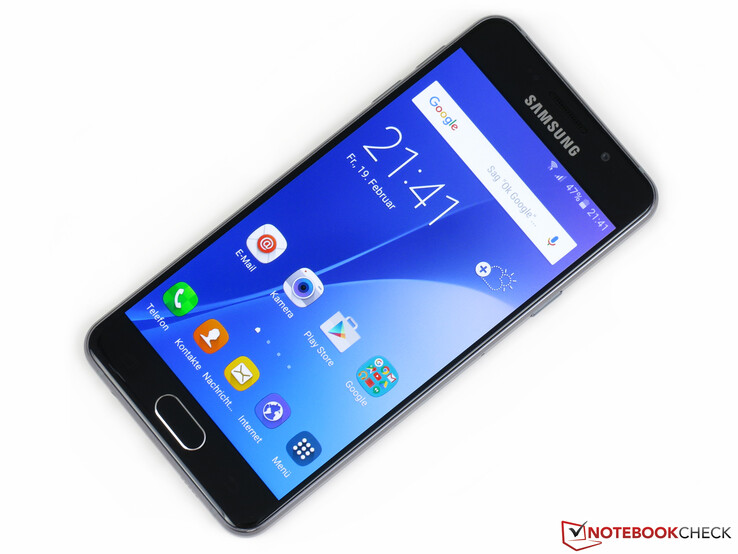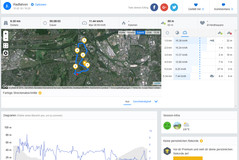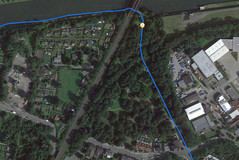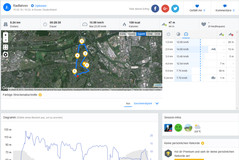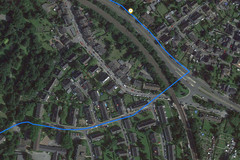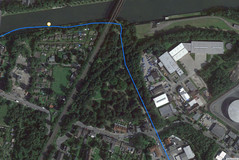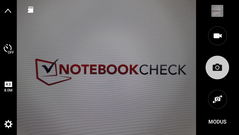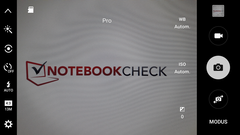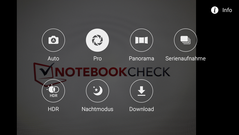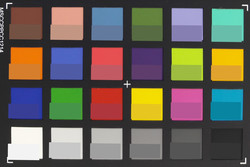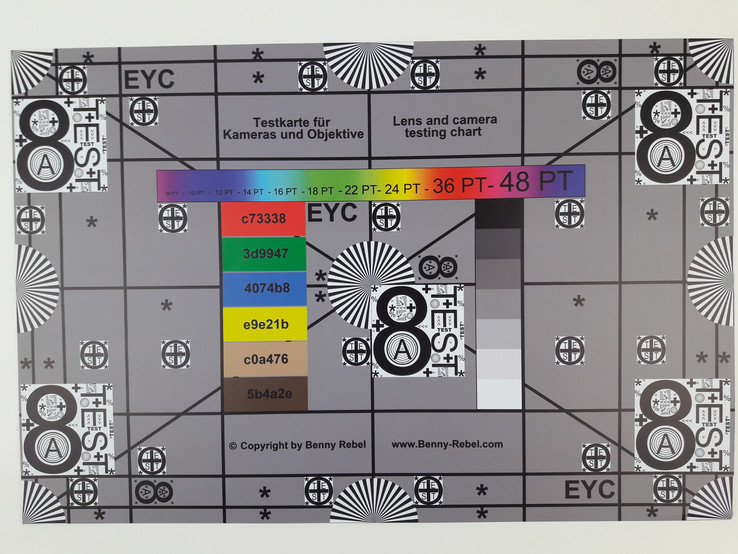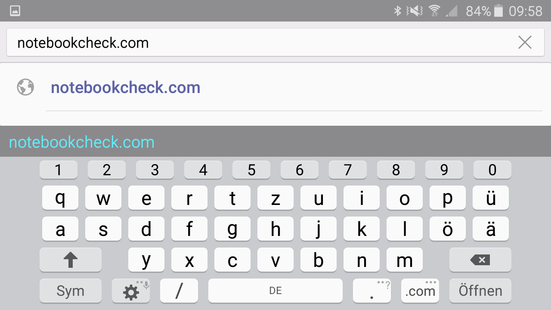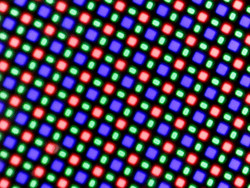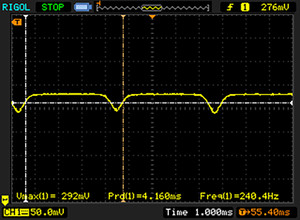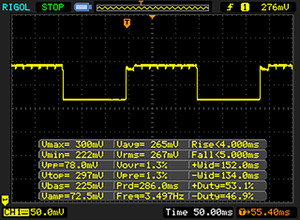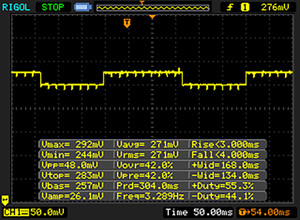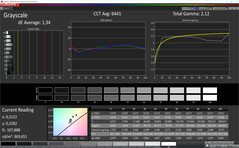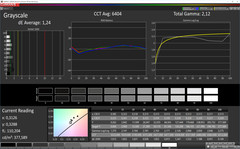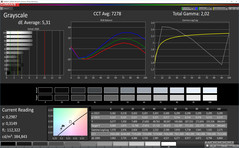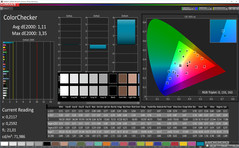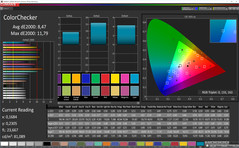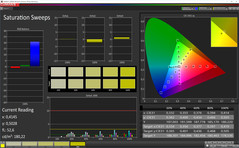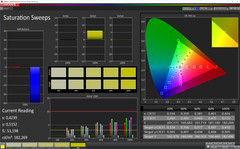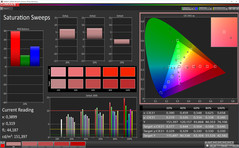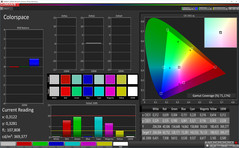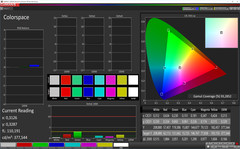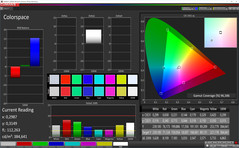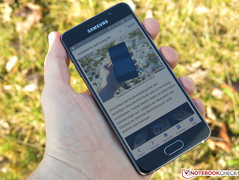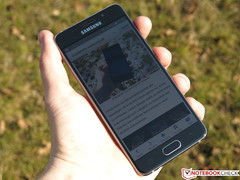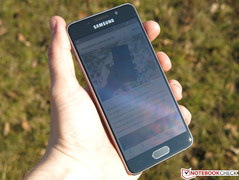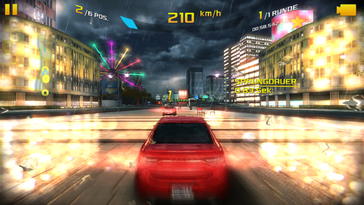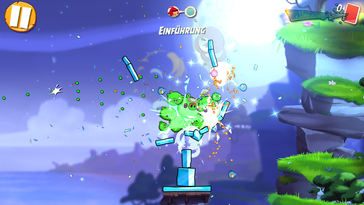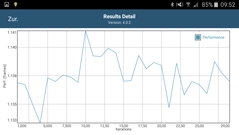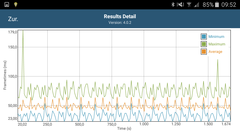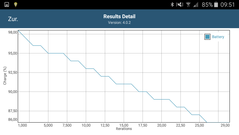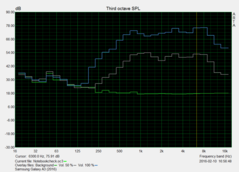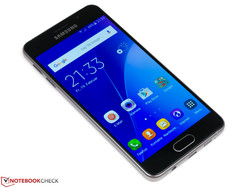Samsung Galaxy A3 (2016) Smartphone Review
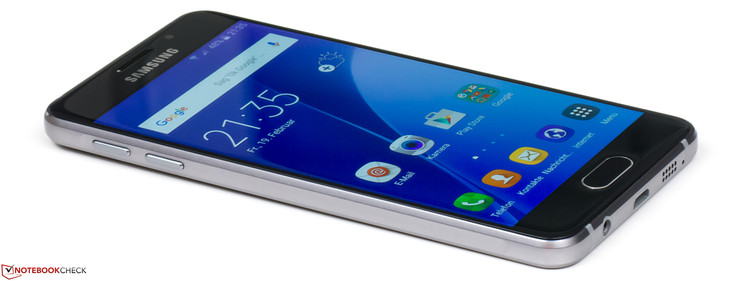
For the original German review, see here.
Like the previous smartphones of the Galaxy A lineup, the new Galaxy A3 wants to stand out from its mid-range rivals with a special design and high-quality build. It is available in black, white, gold and rose gold in Germany. All have 16 GB of storage, 1.5 GB of RAM and the option of expanding the storage via a micro-SD card in common. While the German review sample only supports one nano-SIM card, a dual-SIM model of the A3 is available in other markets.
Listed at a price of 329 Euros (~$362), the smartphone is a bit more expensive than many other mid-range models. However, it could be purchased for about 280 Euros (~$308) at test time. Rivals with an equally sized screen are rare in this price range. Besides the direct predecessor, Wiko's Highway Pure can be counted to them, for example. Handsets with a 5-inch screen, such as Huawei's P8 lite, Motorola's Moto G, or Oneplus' X play in the same league. The Galaxy A3 also finds opponents in its own ranks from Samsung's Galaxy S5 Neo that has dropped in price considerably. Our in-depth review reveals how well the handset fares in this scenery.
Case
Although the new Galaxy A3's 4.71-inch screen is bigger than that of the former model, it is only a bit over 4 millimeters longer. Its width (65.2 millimeters) and height (7.7 millimeters) have hardly changed. It is thus still much more compact than its rivals with 5-inch screens.
In contrast to the dominating aluminum material used on the back of last year's Galaxy A3, it is made of Gorilla Glass in the new edition. The transitions to the metal lateral parts have been rounded, giving it a pleasant texture. The handset thus feels like it is one single part despite the different materials. The build is also on a very high level and is not in any way inferior to many premium-range models. However, a drawback of this design is that the casing's front and back are very sleek, and the smartphone easily slips from slanted surfaces. Also, very fine scratches appeared on our review sample despite careful handling.
The choice of materials also has an unfavorable effect on the weight. Compared with the predecessor, it has increased by 21 grams to 131 grams - the much bigger Huawei P8 lite is only 2 grams heavier. That, however, also contributes to the sensation of holding a particularly high-quality device in our hands.
The new Galaxy A3's stiffness is noticed very positively. It defies bending and warping attempts with flying colors, and without producing noises. Additionally, pressure on the back or front does not cause any distortions in displayed content.
Connectivity
The storage capacity has not changed compared with last year's model. The device is still only available with 16 GB internal storage. Only approximately 10.7 GB of that is left for personal use. However, it can always be expanded via a micro-SD card as usual. Cards with a size of up to 128 GB can be used officially. It is also convenient that the memory card can be hot-swapped. Beyond that, the smartphone supports App2SD.
The interfaces have not been modified, either. Audio signals are transmitted via the 3.5 mm headset jack and a micro-USB port is present for data sharing. The latter supports USB-OTG, but not image output via MHL.
Although the handset can communicate via Wi-Fi Direct, it does not support Miracast. Media streaming via DLNA functioned in the local network without issues. An FM radio is also integrated.
It is too bad that Samsung does not install a dedicated notification LED. Users who do not want to miss this feature can simulate this on the AMOLED screen via third-party apps.
Software
The Android 5.1.1 operating system that Samsung covers with its TouchWiz user interface is installed. When or whether it will be updated to Android 6.0 Marshmallow is not known. However, a firmware update to version A310FXXU1APB7 was offered shortly after the test began, and all benchmarks and battery life tests were performed with it.
Samsung has made some modifications in the user interface. For example, a news-feed screen (Flipboard Briefing) is on the home screen's left by standard, but which can be faded out. A themes manager for adapting the operating system's appearance is also installed. Furthermore, the so-called Smart-Stay feature was enabled by default. It detects the user's face and prevents the screen from turning off regardless of the screen's timeout setting.
We also favorably noticed that Samsung only preloads very few third-party apps. Among them we only find Microsoft's Office apps that cannot be uninstalled but disabled.
Communication & GPS
The new Galaxy A3 only offers the standards in terms of Wi-Fi connectivity. The smartphone only supports 2.4 GHz frequencies, excluding connections to 5 GHz networks. The maximum gross data rate in the author's test setup was 72 Mbit/s (1 antenna, 20 MHz bandwidth) in conjunction with an Asus RT-AC56U router. The reception was on an average level. The smartphone's wireless module supports all frequencies common in Germany as well as LTE Cat.4 (max. 150 Mbit/s download & 50 Mbit/s upload). Bluetooth version 4.1 and NFC are installed for wireless near field communication.
The integrated GPS module very quickly found the actual position outdoors. The reception was barely affected even in many indoor areas, such as a ground-level supermarket. Then again, a stable reception was no longer possible far from a window in an apartment in the third story of a 4-story apartment building. To find out how the handset fares in real-world use, we recorded a route with both the Garmin Edge 500 GPS bike navigation system and the Galaxy A3. Although the area of the railway underpass shows that the smartphone tends to straighten difficult sections, the Garmin navigation system also had some problems. Although its recorded route is clearly not as straight, it consistently deviates a few meters from the actual route to begin with. Since the smartphone does not exhibit any major discrepancies, it should be sufficient for navigating purposes.
Telephone & Call Quality
The Galaxy A3's phone app offers the standard features, such as favorites, a call list and directly accessing the phonebook. A keypad also fades in by default when it is opened.
The call quality was throughout convincing in test calls via the 3G network of the German Telecom. The voice quality was impeccable on both sides during normal calls using the earpiece with its very high volume settings as well as when using the included headset. There was no interference and background noises like traffic were suppressed well. Although the contact perceived the voice of the Galaxy A3 user as marginally quieter in a direct comparison, the sound quality did not suffer. Only the averagely high maximum volume of the smartphone's speaker could lead to problems in noisier environments.
Cameras & Multimedia
The primary camera in the new Galaxy A3 has a resolution of 13 megapixels and offers an aperture of f/1.9. That is a clear improvement over the predecessor that was furnished with an 8-megapixel camera - at least in terms of resolution. However, most rivals now feature an equally good configuration. It is positive that the camera unit only juts out of the casing by approximately 0.8 millimeters, making it possible to place the handset quite stably on its back.
The photos are compelling in bright conditions: Their sharpness, noise behavior and illumination are good (scene 1). However, looking closer at the photos reveals a slight haziness in both upper corners that is, however, only noticed on specific objects. The image quality is poorer in difficult situations - for example in twilight or dim rooms. The image noise then also increases in dark areas (scene 3). Additionally, the occasional blurred photo will be inevitable under these circumstances due to the lack of an optical image stabilizer. The relatively sluggish auto-focus that does not always function accurately in low-light conditions makes things more difficult since it has obvious problems focusing objects. Fortunately, the bright LED flash can lessen the problem a bit - at least in the near field.
The primary camera records videos in at most the Full HD resolution and 30 frames per second. The image quality is very decent, but the auto-focus is also often sluggish here particularly when the scene changes quickly or in difficult light conditions.
The front-facing camera with fixed focus has a resolution of 5 megapixels and provides useful results in good ambient light conditions. However, the photos blur as soon as less light falls on the sensor. It also records videos in the Full HD resolution at 30 frames per second.
The camera's software allows choosing between an "Auto" and "Pro" mode with extra settings, among other things. HDR photos are only possible via a special mode. It is handy that the camera app can be opened directly from standby by double-tapping the home button.
Color Accuracy & Sharpness
To test the color accuracy of the Galaxy A3's primary camera, we compare the screenshot of the X-Rite ColorChecker Passport taken under controlled light conditions with the factual reference colors. The pictures are not edited afterwards, e.g. manual white balance.
The comparison shows that the smartphone almost consistently tends to oversaturate colors as well as slightly increase the brightness. The latter is also true for the medium grayscale levels.
To evaluate the image sharpness, we photographed our test chart as full-frame as possible in defined light conditions. The sharpness decrease particularly in the left upper edge, which was already noticed in the real-world photos, is seen again. The reproduction in the image's center is very decent, and even the iPhone 6S is defeated in terms of resolution here.
Accessories
In addition to the compulsory brochures that include a quick-start guide and warranty conditions, the review sample was shipped with a tool for opening the card slot and a 7.75 watt plug (1.55 A / 5 V) and the corresponding micro-USB cable. Beyond that, a white in-ear headset was included. The manufacturer offers a Flip Cover and a transparent Clear Cover specifically made for the Galaxy A3 at 29.90 Euros (~$32) each.
Warranty
Samsung's warranty covers a period of 24 months. That, however, excludes the battery where a 12-month warranty is stated.
Input Devices & Handling
The review sample's touchscreen protected by Gorilla Glass responds very accurately to inputs and detects the lightest touch reliably. The glass surface has an especially pleasing feel thanks to its rounded lateral edges. The onscreen keyboard can also be used well although the room for it is smaller than in smartphones with bigger screens. Samsung's standard keyboard also supports word suggestions and swiping. The latter has to first be enabled in the settings.
The touch buttons below the screen also do a reliable job. They are backlit for approximately one-and-a-half seconds after an input. All physical keys, i.e. power button, both volume controls and home button, have a crisp pressure point and firm fit. They thus contribute to the smartphone's high-quality looks.
Generally, the operating system mostly responded to the user's inputs without lags. It sometimes only took a moment for opening a function when larger apps were closed or updates ran in the background. The image rotated quickly when turning the smartphone.
Display
Samsung's new Galaxy A3 sports a 4.71-inch Super AMOLED panel with a resolution of 1280x720 pixels. The resulting pixel density of 312 PPI is higher than that of last year's model (245 PPI) despite the bigger screen diagonal. The review sample thus places itself between those rivals with 294 to 441 PPI. However, pixel structures and light color fringing are very visible when looking close at content despite this sufficiently high pixel density. Color fringing could particularly appear at the edges of homogeneously colored surfaces. This minor shortcoming will unlikely be noticed in routine use.
The review sample achieves a brightness of 386 cd/m² in the center on a pure white screen. That seems to be a step backward compared with the precursor's 434 cd/m² at first. However, our more significant measurements with equally distributed bright and dark areas on the screen (Average Picture Level / APL 50) reveals that the new Galaxy A3 still has some reserves. We ascertained a maximum of 466 cd/m². The smartphone even shines with up to 659 cd/m² when the light sensor is enabled. The device additionally benefits from the AMOLED panel's rich black level that leads to a very high contrast both subjectively and objectively.
| |||||||||||||||||||||||||
Brightness Distribution: 88 %
Center on Battery: 386 cd/m²
Contrast: ∞:1 (Black: 0 cd/m²)
ΔE ColorChecker Calman: 1.11 | ∀{0.5-29.43 Ø4.77}
ΔE Greyscale Calman: 1.34 | ∀{0.09-98 Ø5}
Gamma: 2.12
CCT: 6441 K
| Samsung Galaxy A3 2016 1280x720 px 4.71'' (AMOLED) | Samsung Galaxy A3 940x540 px px 4.5'' (AMOLED) | Motorola Moto G 3. Gen 2015 XT1541 1280x720 px 5.0'' (IPS) | OnePlus X 1920x1080 px 5.0'' (AMOLED) | Huawei P8 lite 1280x720 px 5.0'' (IPS) | Wiko Highway Pure 1280x720 px 4.8'' (AMOLED) | Samsung Galaxy S5 Neo 1920x1080 px 5.1'' (AMOLED) | |
|---|---|---|---|---|---|---|---|
| Screen | -47% | -84% | -203% | -143% | -203% | -59% | |
| Brightness middle (cd/m²) | 386 | 434 12% | 418 8% | 312 -19% | 365 -5% | 298 -23% | 334 -13% |
| Brightness (cd/m²) | 394 | 433 10% | 407 3% | 314 -20% | 353 -10% | 298 -24% | 341 -13% |
| Brightness Distribution (%) | 88 | 96 9% | 95 8% | 91 3% | 93 6% | 96 9% | 91 3% |
| Black Level * (cd/m²) | 0.49 | 0.42 | |||||
| Colorchecker dE 2000 * | 1.11 | 2.98 -168% | 3.92 -253% | 6.28 -466% | 5.2 -368% | 6.81 -514% | 2.84 -156% |
| Colorchecker dE 2000 max. * | 3.35 | ||||||
| Greyscale dE 2000 * | 1.34 | 2.68 -100% | 3.81 -184% | 8.24 -515% | 5.85 -337% | 7.53 -462% | 2.91 -117% |
| Gamma | 2.12 104% | 2.44 90% | 2.27 97% | 2.12 104% | 2.17 101% | 2.15 102% | 2.01 109% |
| CCT | 6441 101% | 6603 98% | 7361 88% | 8145 80% | 7252 90% | 8348 78% | 6432 101% |
| Contrast (:1) | 853 | 869 | |||||
| Color Space (Percent of AdobeRGB 1998) (%) | 70.86 | ||||||
| Color Space (Percent of sRGB) (%) | 91.25 |
* ... smaller is better
Screen Flickering / PWM (Pulse-Width Modulation)
| Screen flickering / PWM detected | 240.4 Hz | ||
The display backlight flickers at 240.4 Hz (worst case, e.g., utilizing PWM) . The frequency of 240.4 Hz is relatively low, so sensitive users will likely notice flickering and experience eyestrain at the stated brightness setting and below. In comparison: 53 % of all tested devices do not use PWM to dim the display. If PWM was detected, an average of 8083 (minimum: 5 - maximum: 343500) Hz was measured. | |||
Display Response Times
| ↔ Response Time Black to White | ||
|---|---|---|
| 9 ms ... rise ↗ and fall ↘ combined | ↗ 4 ms rise | |
| ↘ 5 ms fall | ||
| The screen shows fast response rates in our tests and should be suited for gaming. In comparison, all tested devices range from 0.1 (minimum) to 240 (maximum) ms. » 24 % of all devices are better. This means that the measured response time is better than the average of all tested devices (20.2 ms). | ||
| ↔ Response Time 50% Grey to 80% Grey | ||
| 7 ms ... rise ↗ and fall ↘ combined | ↗ 3 ms rise | |
| ↘ 4 ms fall | ||
| The screen shows very fast response rates in our tests and should be very well suited for fast-paced gaming. In comparison, all tested devices range from 0.165 (minimum) to 636 (maximum) ms. » 19 % of all devices are better. This means that the measured response time is better than the average of all tested devices (31.6 ms). | ||
Like many Samsung smartphones, the Galaxy A3 has several color profiles for the user to choose from. "Basic" mode offers the most accurate color reproduction in the sRGB color space: With an average DeltaE shift of 1.34 in grayscale and 1.11 in colors (ideal range: <3), the new Galaxy A3 can clearly outclass all comparison devices and even some considerably more expensive smartphones like the iPhone 6S. The shifts in "Photo" mode focused on the AdobeRGB color space are also within tight limits. That looks different in "Cinema" mode that primarily relies on much higher saturated colors and also has a much cooler color temperature with 7278 K than both other modes (ideal rate: 6500 K; "Basic" 6441 K; "Cinema": 6404 K). Users who do not want to think about the color reproduction can simply leave it up to automatic mode set by default.
The viewing-angle stability of the installed screen is very good as is typical for AMOLED. Inverting is not an issue due to the construction, and the brightness decrease when looking at the screen from the side is marginal. However, a minor drop in color temperature towards cooler colors then becomes visible.
Performance
While last year's model featured a Qualcomm SoC, the new Galaxy A3 sports a chip by Samsung. The new Exynos 7578 quad-core processor has four Cortex A53 cores that clock at a maximum of 1.5 GHz. Like the predecessor, it finds support in a rather scanty 1.5 GB of working memory. Apart from Motorola's Moto G, the comparison devices all have more to offer here. An ARM Mali T720 GPU is responsible for video output.
The review sample holds its ground quite well despite these relatively weak-looking components on paper: While it at least can keep the Snapdragon 410 SoC based rival in check in the AnTuTu benchmark and Geekbench 3, it can even outperform Huawei's P8 lite furnished with an octa-core processor in PCMark. The new Galaxy A3 also looks impressive in the graphics benchmarks.
Although defeated by OnePlus X and the Galaxy S5 Neo in the offscreen tests of 3DMark and GFXBench, the latter is even surpassed in the onscreen benchmarks thanks to its screen's lower resolution. Thus, Samsung's new Exynos 7578 SoC does not ensure any new best rates in the comparison with the rivals, but it can hold its own well especially in the graphics tests.
| AnTuTu v5 - Total Score | |
| OnePlus X | |
| Samsung Galaxy S5 Neo | |
| Huawei P8 lite | |
| Samsung Galaxy A3 2016 | |
| Motorola Moto G 3. Gen 2015 XT1541 | |
| Wiko Highway Pure | |
| Geekbench 3 | |
| 32 Bit Multi-Core Score | |
| Samsung Galaxy S5 Neo | |
| OnePlus X | |
| Samsung Galaxy A3 2016 | |
| Motorola Moto G 3. Gen 2015 XT1541 | |
| Wiko Highway Pure | |
| Samsung Galaxy A3 | |
| 32 Bit Single-Core Score | |
| OnePlus X | |
| Samsung Galaxy S5 Neo | |
| Samsung Galaxy A3 2016 | |
| Motorola Moto G 3. Gen 2015 XT1541 | |
| Wiko Highway Pure | |
| Samsung Galaxy A3 | |
| 64 Bit Multi-Core Score | |
| Huawei P8 lite | |
| Motorola Moto G 3. Gen 2015 XT1541 | |
| 64 Bit Single-Core Score | |
| Huawei P8 lite | |
| Motorola Moto G 3. Gen 2015 XT1541 | |
| PCMark for Android - Work performance score | |
| OnePlus X | |
| Samsung Galaxy S5 Neo | |
| Samsung Galaxy A3 2016 | |
| Huawei P8 lite | |
| Motorola Moto G 3. Gen 2015 XT1541 | |
| Wiko Highway Pure | |
| GFXBench (DX / GLBenchmark) 2.7 | |
| T-Rex Onscreen | |
| OnePlus X | |
| Samsung Galaxy A3 2016 | |
| Huawei P8 lite | |
| Samsung Galaxy S5 Neo | |
| Samsung Galaxy A3 | |
| Wiko Highway Pure | |
| Motorola Moto G 3. Gen 2015 XT1541 | |
| 1920x1080 T-Rex Offscreen | |
| OnePlus X | |
| Samsung Galaxy S5 Neo | |
| Samsung Galaxy A3 2016 | |
| Huawei P8 lite | |
| Samsung Galaxy A3 | |
| Wiko Highway Pure | |
| Motorola Moto G 3. Gen 2015 XT1541 | |
| GFXBench 3.0 | |
| on screen Manhattan Onscreen OGL | |
| OnePlus X | |
| Samsung Galaxy A3 2016 | |
| Samsung Galaxy A3 | |
| Samsung Galaxy S5 Neo | |
| Wiko Highway Pure | |
| Motorola Moto G 3. Gen 2015 XT1541 | |
| 1920x1080 1080p Manhattan Offscreen | |
| OnePlus X | |
| Samsung Galaxy S5 Neo | |
| Samsung Galaxy A3 2016 | |
| Samsung Galaxy A3 | |
| Wiko Highway Pure | |
| Motorola Moto G 3. Gen 2015 XT1541 | |
It looks similar in the browser tests. The Galaxy A3 again places itself in the upper midfield but is almost always defeated by OnePlus X with its high-end Snapdragon 801 SoC and its somewhat more expensive Galaxy S5 Neo sister model.
| Octane V2 - Total Score | |
| OnePlus X | |
| Samsung Galaxy S5 Neo | |
| Samsung Galaxy A3 2016 | |
| Motorola Moto G 3. Gen 2015 XT1541 | |
| Wiko Highway Pure | |
| Samsung Galaxy A3 | |
| Huawei P8 lite | |
| Sunspider - 1.0 Total Score | |
| Huawei P8 lite | |
| Wiko Highway Pure | |
| Motorola Moto G 3. Gen 2015 XT1541 | |
| OnePlus X | |
| Samsung Galaxy A3 2016 | |
| Samsung Galaxy A3 | |
| Samsung Galaxy S5 Neo | |
| Mozilla Kraken 1.1 - Total | |
| Huawei P8 lite | |
| Samsung Galaxy A3 | |
| Wiko Highway Pure | |
| Motorola Moto G 3. Gen 2015 XT1541 | |
| Samsung Galaxy A3 2016 | |
| Samsung Galaxy S5 Neo | |
| OnePlus X | |
| WebXPRT 2015 - Overall | |
| OnePlus X | |
| Samsung Galaxy S5 Neo | |
| Samsung Galaxy A3 2016 | |
| Motorola Moto G 3. Gen 2015 XT1541 | |
| Huawei P8 lite | |
| Wiko Highway Pure | |
| Google V8 Ver. 7 - Google V8 Ver. 7 Score | |
| OnePlus X | |
| Samsung Galaxy S5 Neo | |
| Samsung Galaxy A3 2016 | |
| Motorola Moto G 3. Gen 2015 XT1541 | |
| Wiko Highway Pure | |
| Samsung Galaxy A3 | |
| Huawei P8 lite | |
| JetStream 1.1 - Total Score | |
| OnePlus X | |
| Samsung Galaxy S5 Neo | |
| Samsung Galaxy A3 2016 | |
| Motorola Moto G 3. Gen 2015 XT1541 | |
* ... smaller is better
While the review sample usually places itself in the midfield in the storage benchmarks, it shows a clear weakness in sequential write. It only takes second-last place with 27.27 MB/s. The predecessor can claim the first place with 71 MB/s. However, the read performance - in particular random read of small data blocks - has been considerably improved.
We also tested the micro-SD slot's speed with our Toshiba Exceria SD-CX32UHS1 reference card (UHs-I Class 3, max. read: 85 MB/s, max. write: 50 MB/s). The achieved 80.24 MB/s in sequential read and 36.47 MB/s in sequential write are very good. The interface is considerably weaker in random read (11.21 MB/s) and random write (0.12 MB/s) as is typical for smartphones.
| BaseMark OS II - Memory | |
| Huawei P8 lite | |
| OnePlus X | |
| Samsung Galaxy S5 Neo | |
| Samsung Galaxy A3 2016 | |
| Wiko Highway Pure | |
| Motorola Moto G 3. Gen 2015 XT1541 | |
Games
An ARM Mali T720 GPU is responsible for video output in the Galaxy A3 (2016). It does its job amazingly well: Even performance-driven games like Asphalt 8 are still smooth in high settings. The smartphone certainly benefits from its not extremely high screen resolution of 1280x720 pixels. The graphics chip would have to work harder for the same performance with a Full HD panel. Of course, games like Angry Birds 2 that do not have such high hardware requirements run smoothly on the handset.
The integrated position sensors and sensitive touchscreen also function impeccably in games.
Emissions
Temperature
The Galaxy A3 shines in terms of maximum heat dissipation. Idle temperatures of below 30 °C are nothing special, but the smartphone fares particularly well under load. Like the slightly bigger Galaxy S5 Neo, the review sample reaches at most a moderate 34.7 °C here. Only the direct predecessor does an even better job. OnePlus' X proves that not every smartphone can offer these low temperatures with a hot spot of 47.5 °C.
We use the battery test of GFXBench to check whether these agreeably low temperatures are not the result of a continuous performance reduction of the installed components. It runs the T-Rex test 30 times in succession and records both the available performance and battery consumption. Fortunately, the outcomes only deviate within a range of one percent point, which excludes throttling.
(+) The maximum temperature on the upper side is 34.7 °C / 94 F, compared to the average of 35.2 °C / 95 F, ranging from 21.9 to 247 °C for the class Smartphone.
(+) The bottom heats up to a maximum of 33 °C / 91 F, compared to the average of 34 °C / 93 F
(+) In idle usage, the average temperature for the upper side is 28.8 °C / 84 F, compared to the device average of 32.9 °C / 91 F.
Speaker
While the speaker in last year's Galaxy A3 was still found on the rear, it is now situated on the handset's lower edge. Thus, sound is no longer impaired when the smartphone is placed on a table.
Subjectively, the sound quality is surprisingly good for a mono speaker. Music and voice are rendered quite naturally and balanced, and even some bass is audible. Tones are not distorted even at maximum volume, which could be a bit higher, though.
We measured the speaker's sound and created a Pink Noise diagram. It illustrates that the mid to high frequencies of approximately 600 Hz to 12 kHz are rendered relatively consistently. The maximum volume of 84.38 dB(A) is sufficiently high to at least fill smaller rooms with sound.
Unlike the inferior headphones found in the boxes of some mid-range devices, Samsung includes a decent headset that reaps in plus points with its vivid bass and balanced sound.
Energy Management
Power Consumption
In terms of power consumption, the review sample does a much better job than its somewhat bigger sister model Galaxy S5 Neo. Although the rates have clearly climbed compared with the Galaxy A3 from 2015, they can only be compared conditionally because we have been using a new and more accurate measuring device recently. However, OnePlus' X proves that even less is possible with better rates despite the new metrology.
The included power supply has a maximum output of 7.75 watts and completely recharges the non-removable battery with a capacity of approximately 8.7 Wh within 2 hours. The Galaxy A3 cannot offer wireless charging or Quick Charge functionality.
| Off / Standby | |
| Idle | |
| Load |
|
Key:
min: | |
Battery Runtime
The new Galaxy A3's time has come in battery life. It is superior to the comparison devices in virtually every test. Only the Galaxy S5 Neo lasts a bit longer in full load. The comparison with Huawei's P8 lite shows just how big the advantage sometimes is: While the review sample managed a very good 14 hours and 23 minutes in video playback, the rival is depleted in not even half the time. However, it must be pointed out that the brightness is automatically dimmed at a battery state of less than 5%, and it cannot be increased manually.
Additional energy-saving mechanisms can be enabled to increase the smartphone's battery life even more. Besides the standard energy-savings mode that is to save energy via reduced performance, disabled key light and reduced frame rate frequencies, an ultra-energy-savings mode is present. It strongly limits the usability of apps and switches to grayscale display mode.
| Samsung Galaxy A3 2016 Mali-T720 MP2, 7578, 16 GB eMMC Flash | Samsung Galaxy A3 Adreno 306, 410 MSM8916, 16 GB eMMC Flash | Motorola Moto G 3. Gen 2015 XT1541 Adreno 306, 410 MSM8916, 8 GB eMMC Flash | OnePlus X Adreno 330, 801 MSM8974AA, 16 GB eMMC Flash | Huawei P8 lite Mali-450 MP4, Kirin 620, 16 GB eMMC Flash | Wiko Highway Pure Adreno 306, 410 MSM8916, 16 GB eMMC Flash | Samsung Galaxy S5 Neo Mali-T720 MP2, 7580 Octa, 16 GB eMMC Flash | |
|---|---|---|---|---|---|---|---|
| Battery runtime | -36% | -25% | -28% | -54% | -42% | -9% | |
| Reader / Idle (h) | 33 | 18 -45% | 22.7 -31% | 16.1 -51% | 11.9 -64% | 20.6 -38% | 26.9 -18% |
| H.264 (h) | 14.4 | 10 -31% | 11.3 -22% | 8.6 -40% | 6.2 -57% | 7.8 -46% | 12.9 -10% |
| WiFi v1.3 (h) | 10.5 | 8.8 -16% | 9.2 -12% | 5.9 -44% | 7.9 -25% | 9.1 -13% | |
| Load (h) | 6.3 | 4.3 -32% | 4.4 -30% | 5.7 -10% | 3.2 -49% | 2.7 -57% | 6.7 6% |
| WiFi (h) | 9.5 |
Pros
Cons
Verdict
Samsung's reiteration of the Galaxy A3 holds many advantages. One is the stiff casing's high-quality build that tactually convinces with rounded glass at the edges and a metal bezel. Drawbacks of this design are the non-removable battery and the slightly too sleek back.
However, the device has quite a bit to offer technically. The excellent screen, the option of expanding the 16 GB internal storage via micro-SD and very long battery life are primarily convincing. Qualities that many smartphone users will appreciate. While NFC is on board, the integrated Wi-Fi module unfortunately still only supports data sharing via the 2.4 band. Samsung's new quad-core SoC does not break any records, but it convinces with performance suitable for routine use in the Galaxy A3.
In contrast to that, the quality of the installed camera modules makes a mixed impression. While photos taken in good light conditions are very compelling with their decent sharpness and good resolution, less ideal conditions often cause disappointment. The sluggish and frequently inaccurate auto-focus and the tendency to underexpose the photos are aggravating here.
Samsung has created an especially high-quality mid-range smartphone that can primarily convince with an excellent screen and outstanding battery life.
Equally priced alternatives for the Galaxy A3, which have a similar screen size, are rare. Users who do not have problems with a bigger screen could take a look at, for example, the somewhat more expensive Galaxy S5 that achieved an even better total rating of 87% in our test.
Samsung Galaxy A3 2016
- 02/29/2016 v5 (old)
Andreas Kilian


